#lostwithiel
Text
In September 1644, after the Parliamentary surrender of Fowey to the king, a Lostwithiel woman who had given birth only three days before died after being stripped naked and thrown in the river.
"Normal Women: 900 Years of Making History" - Philippa Gregory
#book quote#normal women#philippa gregory#nonfiction#september#40s#1640s#17th century#parliamentary#surrender#fowey#charles i#lostwithiel#death#stripped#river#violence against women
0 notes
Text
Lostwithiel Cornwall
The town of Lostwithiel is just 3 miles from where I live, it has such a rich and vibrant history, and it dates back as far as the 12th century. It is set in the most stunning countryside and is right on the bank of the river Fowey, and at one point in history it was a very busy port, mostly for tin. The river is not as deep as it once was, but is still very popular to swim in and kayak. I love…

View On WordPress
#Alice In Scandiland Shop Lostwithiel#cafes in cornwall#good cafe in lostwithiel#mid cornwall#pretty cornwall#Q Street Coffee Lostwithiel#The Mess Hall Cafe Lostwithiel#visit lostwithiel#Visit Lostwithiel Cornwall
7 notes
·
View notes
Text


The Prince of Wales loves the smells of roses as he visits The Duchy Of Cornwall Nursery to open The Orangery restaurant in Lostwithiel, United Kingdom | July 10, 2023
149 notes
·
View notes
Text


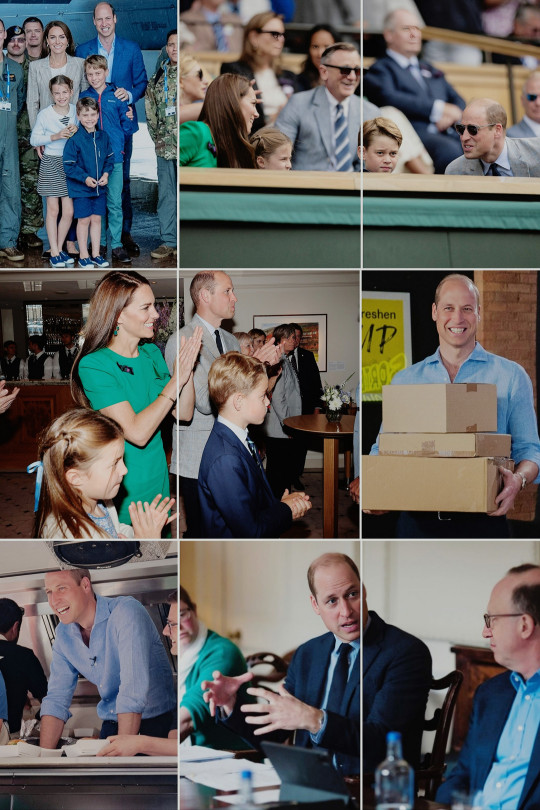
─ • ✧ WILLIAM'S YEAR IN REVIEW : JULY ✧ • ─
1 JULY - William and George attended the Fourth Day of the 2nd Ashes Test Match at the Lord's Cricket Ground in London.
3 JULY - William gave a boost to Dame Deborah James' charity single - 'Tell Me it's Not True'. Later, in the evening he gave an Earthshot Prize Dinner at Windsor Castle.
4 JULY - He received The Crown Prince of the Kingdom of Bahrain at Windsor Castle.
5 JULY - William and featured in a series of photographs and short film as they attended a Tea Party at St. Thomas Hospital to celebrate the NHS's 75th anniversary. The Duke and Duchess of Rothesay attended Service of Thanksgiving and Dedication to celebrate the Coronation at St. Giles' Cathedral. Afterwards, they witnessed an RAF Fly-past from the Palace of Holyroodhouse.
6 JULY - William was accompanied by Catherine as he participated in the Royal Charity Polo Match at the Guards Polo Club.
10 JULY - William reopened the newly renovated Duchy of Cornwall Nursery in Lostwithiel where he was received by Mr. James Williams (Vice Lord-Lieutenant of Cornwall).
11 JULY - He visited Wistman’s Wood in Dartmoor.
13 JULY - He was represented by Commander Robert Dixon RN at the Service of Thanksgiving for the Life of Admiral of the Fleet the Lord Boyce KG.
14 JULY - William and Catherine along with George, Charlotte and Louis were received by Air Marshal Sir David Walker (Deputy Lieutenant of Gloucestershire) at the Royal International Air Tattoo at Royal Air Force Fairford.
16 JULY - William along with Catherine, George and Charlotte to the Gentlemen's Final of the Wimbledon Tennis Championships.
25 JULY - He became the Patron of The Fleming Centre Appeal.
30 JULY - William appeared in a video with Sorted Food as they made 'Earthshot' burgers. He also joined them in a Food Truck distributing burgers to the members of public.
31 JULY - He held a Meeting at Windsor Castle.
#british royal family#british royals#royalty#royals#brf#british royalty#royal#review 2023#review july#year in review : william#year in review 2023 : william#year in review : 2023#william review : july#prince of wales#the prince of wales#prince william#william prince of wales#catherine princess of wales#princess of wales#the princess of wales#princess catherine#princess charlotte#prince louis#kate middleton#catherine middleton#duchess of cambridge#prince george
27 notes
·
View notes
Text



The Duke of Cornwall officially opens The Orangery restaurant, at The Duchy Of Cornwall Nursery in Lostwithiel, England -July 10th 2023.
#prince william#prince of wales#duke of cornwall#british royal family#england#2023#july 2023#cornwall 2023#cornwall#the orangery#the wales#my edit
26 notes
·
View notes
Note
On the ON post they Lostwithiel Zinc as her manager. Funny how this conversation turns my stomach, anons talking erasure!!! Shut up.... you don't know these people, hell none of us know Zendaya, we think we do but the plain simple reality is we don't.. anybfan who says they do are kidding themselves
Why do you think that specific conversation is something that bothers you so much?
Because everything that anon mentioned are things z publicly shared throughout her career and zink is someone who is not that rarely seen in background of pics and videos of z, but is not mentioned on here that often as opposed to darnell for example
3 notes
·
View notes
Video
undefined
tumblr
A proof of concept animation I made in 2022 showcasing this wild mish mash of a world I’m making! Think France, but also think of it being draped in Y2K aesthetics, clothing and culture : )
VA: Océane Lanteigne
Music: The Road to Lostwithiel- BT (1997)
19 notes
·
View notes
Text

16 July 2019 | Prince Charles, Prince of Wales and Camilla, Duchess of Cornwall attend a reception to celebrate the 50th Anniversary of his chairmanship of the Duchy of Cornwall Prince's Council at the Duchy of Cornwall Nursery in Cott Rd, during an official visit to Devon & Cornwall in Lostwithiel, United Kingdom. (c) Ben Birchall - WPA Pool/Getty Images
#Camilla#Duchess of Cornwall#Queen Camilla#Prince Charles#Prince of Wales#King Charles III#Britain#2019#Ben Birchall#WPA Pool#Getty Images
6 notes
·
View notes
Text






The Duke of Cornwall visits The Duchy Of Cornwall Nursery to open The Orangery restaurant in Lostwithiel | July 10th, 2023
6 notes
·
View notes
Note
Trick or treat!
Treat! 🎃
Here’s a lady pirate for you!
Mary Wolverston (who is frequently confused with her mother in law Elizabeth) married into the wealthy Cornish family the Killigrews. The Killigrew family were an old family and Pendennis Castle (built by Henry VIII) was included on their Arwenack Estate. Her husband John IV had been taking advantage of his high position (MP to Lostwithiel once and Penryn twice as well as just having insane generational wealth and a large estate) and his control of the world’s third largest natural harbour to bribe officials and take advantage of ships coming in. Mary also joined in and at some point became much more involved than her husband. So involved, in fact, that she actually had buried treasure in her garden (probably). Classic pirate trope.
So then, it’s 1582 and Mary hears about the Spanish merchant Marie of San Sebastián and ordered some of her servants to raid it. By most accounts, it does not appear that Lady Killigrew was present for the raid and outsourced it to her servants — as well, she was in her 60s by this point. And while the raid was successful, Mary was then arrested and accused of fencing the goods after the raid. She was sent to trial and sentenced to death. Two of her servants were killed. Lady Killigrew, however, was pardoned by Queen Elizabeth I due to some not insubstantial bribery on her son’s part. The date of her death is unknown, however today she is known as The Queen of Kernow or the Pirate Queen of Cornwall. To be sure, there’s quite a lot of romanticism surrounding her story, but nevertheless she really was tried for piracy in her 60s, was pardoned by the Queen and has quite the legacy today.
I recommend Dame Killigrew and the Spanish Ship by Michell Whitley for some further reading. There’s quite a lot of mythology and just straight up lies about Mary Killigrew neé Wolverston, so I highly recommend looking into it more if you’re interested!
Here’s a photo of the Killigrew Monument in Falmouth (as I can’t find a reliable portrait of the lady herself). Happy Halloween!!
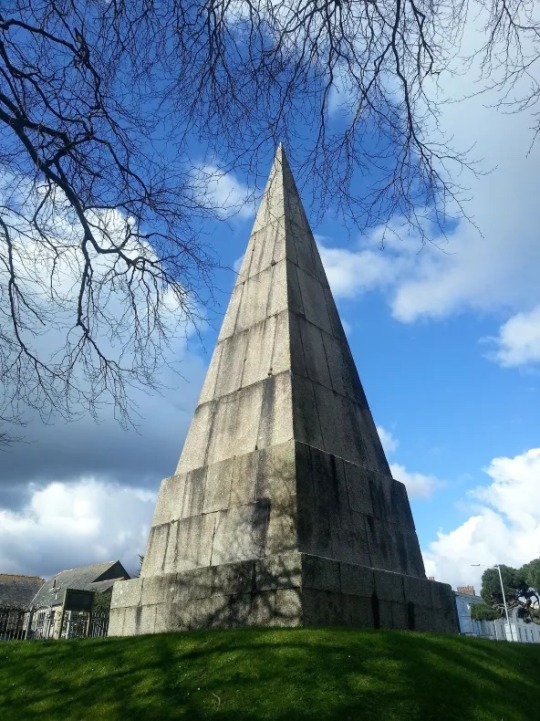
#tried to be as accurate and such for a quick ask but there’s A Lot more#the Killigrews are sometimes referred to as a crime family#Mary herself was described in less than kind words#I was nearly in a film about her - as one of the Spanish sailors#John Killigrew is VERY OFTEN depicted as a cruel vicious man#I’ve even read some fiction where he’s this horrible womanising abuser#I can’t find anything to corroborate that…..#ANYWAYS I THOUGHT THAT YOU MIGHT LIKE A LADY PIRATE!!!#trick or treat#ask#what’s scarier than the rich abusing their privilege#(me trying to make this kind of Halloween themed lol)
2 notes
·
View notes
Text


Prince William, (Duke of Cornwall) Prince of Wales visits The Duchy Of Cornwall Nursery to open The Orangery restaurant on July 10, 2023 in Lostwithiel, United Kingdom.
3 notes
·
View notes
Text
Parliament Loses the Initiative: ‘It Was Easy to Begin the War, but No One Knew Where it Would End’
The King Resurgent
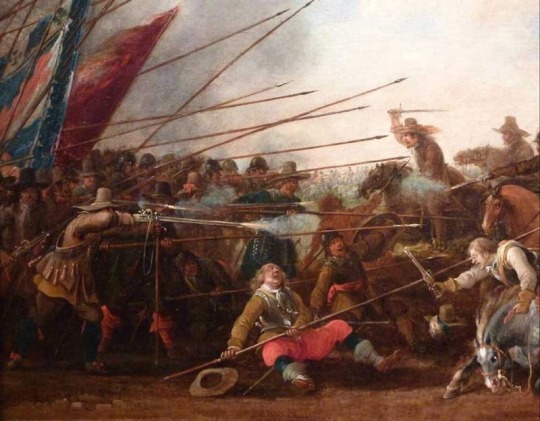
Second Battle of Newbury by Pieter Meulener. Source: Newbury History
MARSTON MOOR arguably changed the nature and course of the war in a number of ways. It was a huge Parliamentary victory, in a conflict which had not seen many Roundhead triumphs to date. It therefore gave the Parliamentary government real hope that they could defeat the King’s forces and require Charles to discuss a new settlement on Parliament’s terms. It was also the bloodiest battle that the war had seen, with large casualties and vicious fighting: if until that point the war still had an air of being conducted by gentleman amateurs engaged in a family squabble, Marston Moor made the war uncompromising and existential. The battle also resulted in the permanent Parliamentary and Covenanter occupation of the North of England: there would be no Royalist resurgence in the North. However, for all its significance, Marston Moor was not decisive, and the ineptitude of the Parliamentary war effort in the late summer and autumn of 1644, allowed the King back into the contest, and demonstrated clearly that Parliament’s informal and aristocratic led military structure was unlikely to bring the war to a successful conclusion.
Parliament’s response to the stunning victory at Marston Moor in the August of 1644, was that of inactivity. Fairfax and Leven, seemingly content with the capture of York, stayed in the North and made no attempt to press their advantage by moving on the Royalist Midlands; the Earl of Manchester failed to bring his Eastern Association army to the defence of London as Parliament wished, despite the threat of a Royalist invasion of East Anglia having been ended by Marston Moor, and the Earl of Essex, on his own initiative, embarked on a quixotic raid on the West Country, possibly motivated by a desire to secure his place in a postwar government on the assumption the King soon sued for peace. This situation was indicative of the woes at the heart of the Parliamentary military structure - it was divided between powerful landholding commanders who made their own decisions, often in defiance of the Parliamentary civilian leadership and rarely in co-ordination with one other.
Essex’s campaign began with the relief of the sieges of both Lyme and Plymouth, which was in accordance with the wishes of the Committee of Both Kingdoms, but he then marched on Exeter, in the hope of capturing Queen Henrietta Maria, who was in residence there, hoping to use a captive queen to induce the King to negotiate. Henrietta Maria, however, escaped to the continent, and Essex suddenly found himself pressed by a large Royalist army, led by Charles himself out of Oxford, intent on rescuing his wife. Essex found himself trapped between the Royalist assault and the sea. On 31st August, in the heart of Royalist Cornwall, Charles surrounded Essex’s forces at Lostwithiel. Essex realised his position was hopeless. He escaped from the town by fishing boat, ordering 6,000 infantry under Sir Philip Skippon to surrender on the best terms they could, arguing he was too eminent commander to be allowed to fall into the hands of the enemy. Skippon sought terms on 2nd September and his army was allowed by Charles to depart for Parliamentary territory, retaining their banners and personal arms. Their retreat however was a miserable affair, with the defeated Roundheads suffering abuse and physical assault from a jeering, triumphant Royalist soldiery.
Despite this unexpected victory, Charles’ strategy remained essentially defensive. The Committe, alarmed at Essex’s ignominious failure, again worried that the King might make a dash for London and try to end the war by overthrowing the Parliamentary leadership. It therefore ordered troops commanded by William Waller, which had previously unsuccessfully tried to prevent the King from re occupying Oxford, to enter Dorset to stymie any Royal advance out of the West Country; Manchester meanwhile finally followed orders and marched the Eastern Association army towards Reading. Charles was as alarmed by these moves as Parliament had been by his own. His main concern was to safeguard Oxford, which meant he was intent on securing Oxfordshire and the passages into Royalist Wales. He was to be helped by a demoralised, but still energetic Prince Rupert, who put together a new army, consisting of the remnants of the Earl of Newcastle’s northern forces combined with a new cavalry troop, called the Northern Horse, led by Sir Marmaduke Langdale. By mid October 1644, therefore, both sides had considerable forces at their disposal. Manchester and Waller combined their armies into a single formation 18,000 men strong, and headed west to engage the Royalists. The armies met again at Newbury on 26th October. The Parliamentarians outnumbered that of the King, who had yet to be joined by Rupert and Langdale, by almost two to one, but the Roundhead attack was hobbled by a joint leadership run by a reactive committee. Manchester came up with an eccentric battlefield strategy involving a separation of his own and Waller’s forces in an attempted pincer movement which was too slow and in the event poorly co-ordinated. Militarily, the Roundheads were found wanting: Cromwell’s cavalry was uncharacteristically ineffective, while Manchester, more typically, failed to press his tactical advantage or deliver his part of his own battlefield strategy. In contrast, the Royalist army fought with skill and bravery and although no side obtained outright victory, it was Charles who extracted his army with relatively few casualties. His Parliamentary opponents were left both frustrated and dispirited.
If the Parliamentary commanders were aware that they lost an opportunity possibly to defeat the King decisively at the second Battle of Newbury, matters were made infuriatingly worse on 9th November, when Charles reappeared outside the town at a settlement called Speenhamland and offered battle again. There was some skirmishing, but Manchester refused to attack, unnerved by the presence of Rupert’s new army, much to the chagrin of Oliver Cromwell*, which allowed Charles to proclaim victory. He then led his forces to the relief of Banbury, thus securing the approach to his capital. Going into winter quarters in Oxford in late November 1644, the resurgent King could look back on the autumn with some satisfaction. Despite the loss of the North, he had consolidated Royalist control of the West and Wales and, reinforced by his nephew, was still in striking distance of London. Royalist hopes of prevailing in the conflict remained undimmed, despite the shock of Marston Moor. However, morale within the Committee was much less high. The Commons fell into mutual recrimination as to how a war that had seemed all but won in August, could have returned to uncertainty and genuine fear of an ultimate Royalist victory.
For some time, MPs had, very broadly, been divided into a “Peace Party” and a “War Party”. The former wished for an early negotiated end to the conflict that would see the withdrawal of an imposed Book of Common Prayer, the establishment of fixed Parliamentary sessions and formalised Parliamentary influence on the running of the Kingdom, but would nonetheless re-establish a loyal partnership between the King and his Parliament within a new constitutional settlement. The latter, however, although it fundamentally distrusted Charles personally, it also believed monarchical authority as exercised by James and Elizabeth before him, was unacceptable, leading to religious persecution and the end of meaningful role of Parliament in the governance of the Kingdom. It wished to see complete military victory over Charles, after which a new settlement, in which the monarch would undertake an essentially symbolic role and power would be vested in the Commons, could be dictated to the King. The events of 1644 however, opened up new and significant divisions. The Solemn League and Covenant may have brought the Scots into the war on Parliament’s side, but the price to be paid - the introduction of Presbyterianism as the only recognised form of worship in the two kingdoms - was considered too high by the majority of English Parliamentarians who were neither Episcopalians nor extreme Presbyterians. This group increasingly referred to themselves as “Independents”, reflective of newer, more primitive, forms of Calvinist religion that many of them espoused. They were as determined to frustrate the aims of the Covenanters as the Scots were to see the bargain upheld. The Independents would become an increasingly vocal and influential faction as the war and its associated politics progressed.
The final division was more practical. It was one exemplified by the dilettante aristocrats the Earls of Essex and Manchester on one side and the competent soldiers Cromwell and Waller on the other. For the latter, Essex’s defeat in Cornwall and Manchester’s wasted opportunity at second Newbury, were unforgivable and went to the heart of why Parliament remained in danger of losing the war. In the view of these up and coming members of the militarised gentry, the war could no longer be conducted by gifted (or not so gifted) amateurs. The Parliamentary forces needed to become truly national, under a unitary command and characterised by discipline and professionalism. As the winter of 1644/45 commenced, the stage was to be set for the emergence of the New Model Army.
* Cromwell claimed in the furious debates on the failures in the West, that Manchester explained his refusal to engage the King at Speenhamland thus: “If we beat the King ninety nine times, he will still be our King and we his subjects. If he beats us but once, we shall all be hanged.”
3 notes
·
View notes
Text



The Prince of Wales joined by two children on cutting the ribbon, as he officially opened The Orangery in Duchy of Cornwall Nursery, based near Lostwithiel, Cornwall | July 10, 2023
154 notes
·
View notes
Text








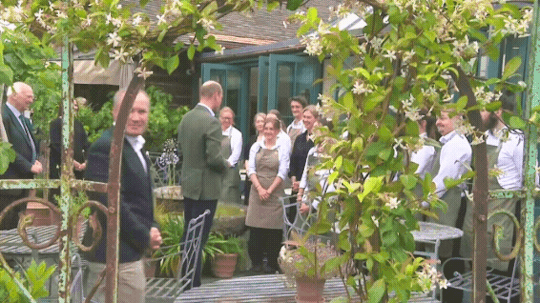
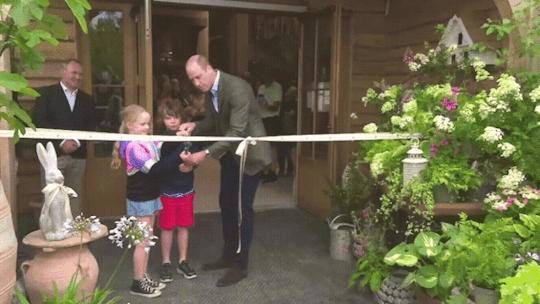


THE PRINCE DIARIES ♚
10 JULY 2023 || DUCHY OF CORNWALL NURSERY - THE ORANGERY OPENING, LOSTWITHIEL
The Prince of Wales who is The Duke of Cornwall visted the Duchy of Cornwall Nursery near Lostwithiel to oficially open its new restaurant - The Orangery.
The Orangery has been built as part of a nine-month extension project to create sustainable visitor spaces at the nursery.
The Duchy of Cornwall Nursery, was originally a slate quarry. It began life producing forest trees in the late 1960s. And selling plants to the public in 1974, going on to become one of the largest nurseries in the south west. The nursery prides itself on using sustainable practices, where horticulture is celebrated, and nature is allowed to flourish.
On arrival, William visited the building’s new central atrium where he met and spoke with staff as well as Duchy of Cornwall employees who were involved in the extension project.
Continuing through to the glasshouse of the original nursery building which is the home to the most comprehensive range of indoor plants, cacti, succulents and air plants for retail in the south west, he visited the Bumblebee Garden.
Utilising the extra space and working alongside the Bumblebee Conservation Trust, the nursery has planted a patchwork of different flowers aimed at creating the perfect home to aid the declining bumblebee population. The project has inspired visitors to create bumblebee habitats within their own domestic gardens.
Finally, the Prince of Wales officially opened The Orangery which overlooks Restormel Castle. It will serve seasonal menus using herbs from the kitchen garden at the nursery and taking influence from local farms and the Cornish coastline.
#prince of wales#the prince of wales#prince william#william wales.#william wales#10072023#british royal family#british royals#royalty#royals#brf#british royalty#royal#royaltyedit#royalty edit#duchy of cornwall#duchy of cornwall nursery 23#my gifs#gifs#duke of cornwall#the duke of cambridge#duke of cambridge#prince of wales diaries#prince of wales diaries 23#the prince of wales diaries#the orangery opening 23#my edit#edit
53 notes
·
View notes
Text




The Duke of Cornwall officially opens The Orangery restaurant, at The Duchy Of Cornwall Nursery in Lostwithiel, England -July 10th 2023.
#prince william#prince of wales#duke of cornwall#british royal family#england#2023#july 2023#the orangery#cornwall 2023#cornwall#the wales#my edit
9 notes
·
View notes
Text
Lostwithiel is just the prettiest town name ever
#it sounds like something from the lord of the rings#so pretty#man rick stein can talk about cornwall#translation seems never-ending today#of course that might also be because during the time I should have been working I've half written two fics#and now I'm on tumblr
1 note
·
View note